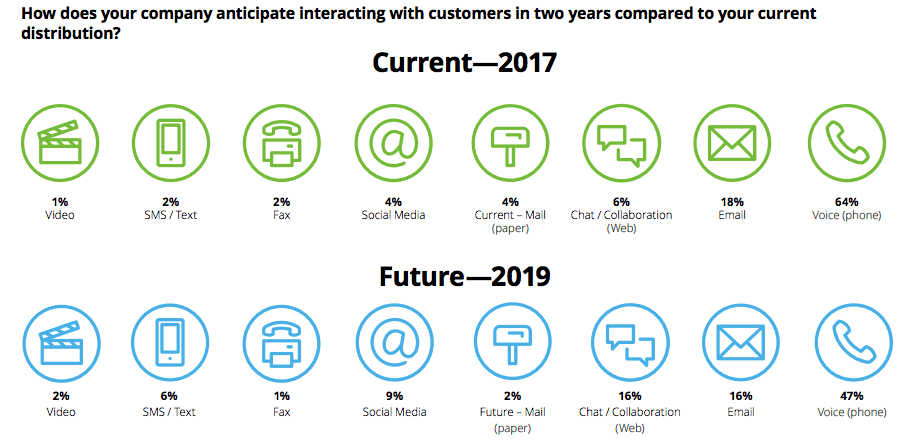"Trend" can have a positive or negative connotation.
Some trends are fads, like blazers with massive shoulder pads or cell phone belt clips.
On the other hand, trends can be lasting landscape changes. Some trends—that supercomputer in your pocket, for example—are thankfully here to stay, at least until a newer, better version comes along.
In the moment, when you're running a small business, it can be hard to tell which trends are here to stay and which aren't.

When it comes to managing a call center, you want to be on the cutting edge of your industry without falling for every new fad that comes along. To do that, you have to stay informed and make decisions about which trends to adopt.
One way to tell which trends to pay attention to is to look at the call center landscape. What are market experts writing and talking about? And what does all of it mean for your business?
3 trends that are making a lasting impact on the call center industry
Below, I've identified three trends that are changing the way call centers do business. I've also paired each trend with some advice on how small business can prepare for them.
Trend 1: Digital transformation
Right now, call centers focus exclusively on calls, while contact centers focus on telephone, email, and online communications.
But both should be focusing more on online communication.
As of 2016, 42% of all customer interactions had become digital. By 2019—according to Deloitte's 2017 Global Contact Center Survey—50% will be digital.
The same survey also shares predictions about future customer interaction channels:

Deloitte Global Contact Center Survey predictions about customer interactions in 2019 (Source)
Generation Z (people born after 1995) will form a full 30% of the U.S. population by 2020. One natural result of this population shift is changes in customer interaction preference.
"Their lives are defined by digital interactions—from the way they communicate with friends and family to how they make major purchases and communicate with brands. They ... are less likely to consider calling a live agent for a customer service issue, and are increasingly attracted to the effortless experiences provided by digital messaging."
Anaal Patel, SparkCentral
Small and midsize businesses often have smaller budgets, which can be a double-edged sword for digital transformation. On the one hand, the benefits of moving communications from phone to online channels are huge. On the other, experimenting with offering new channels takes money.
How to prepare your call center for digital transformation:
With the increasing usage of digital channels, call centers need to expand and create omnichannel experiences for their customers. Take advantage of your nimbleness (compared to enterprise competitors) by running smaller experiments with new channels.
Today, the customer experience still varies across channels. Only 36% of contact centers can track a customer journey across multiple channels. These disparate experiences and frustrated customer journeys will only increase as contact centers expand to support interactions on mobile apps and social media platforms.
The good news is that you can use technology to provide more consistent and comprehensive experiences. Choose call center software with live chat functionality, which not only makes it easier to offer phone-averse customers access to help but also facilitates a consistent experience since all customer information moves seamlessly between channels for agents.
Trend 2: Better analytics
Call centers are starting to increase their use of analytics to better understand how decisions impact their bottom line. For example, many call center managers are now tracking customer experience and churn rate because they're seeing how closely those metrics align with revenue.
Customer happiness drops and churn rate bumps are canaries in the proverbial coal mine; companies need to keep a close watch on these metrics to know when they need to change something about the way they're doing business.
Today, only 17% of call centers can identify the friction points that cause negative customer experiences. Expect that number to go up considerably over the next few years as call centers realize the financial power of harnessing metrics.
The current economic climate is driven by data, so it makes sense that more and more brands are developing long-term strategies to manage and analyze relevant consumer data.
How to prepare your call center for data analytics
Call centers can offer a more personalized, efficient call when they have customer demographic information, history, interests, and preferences displayed in an easy-to-scan format. This means customers spend less time repeating themselves and explaining their history and get faster resolutions.
This type of data can be helpful for improving customer satisfaction. However, in today's world, it isn't enough to simply collect and display the data. Forward-looking call centers should employ more robust and targeted customer satisfaction metrics and track customer experience across digital channels.
Call centers need to invest in advanced analytical technologies that will help them achieve these goals. Call center software with reporting and analytics functionality is a great way to do just that.
Trend 3: Onshore but remote workers
Offshore call center agents often require less overhead and more flexible working hours. That doesn't mean, however, that is the best option for your business. Gartner analysts identified a positive relationship between customer experience and repeat business, along with other positive outcomes.
According to "Marketing Metrics: The Definitive Guide for Measuring Marketing Performance," it's three to 14 times easier to sell to an existing customer than it is to acquire a new one. You've got a 60 to 70% chance of selling to an existing customer, while your likelihood of selling to a new prospect averages 5 to 20%.
As CX's importance to a company's bottom line continues to increase, it's becoming penny wise and pound foolish to cut costs in a way that also cuts into customer happiness. And few things decrease customer happiness more than being frustrated by language and culture barriers.
Another related trend is that companies are sending more of their routine interactions to bots to cut costs, reduce errors, and increase efficiency. (Read more: "Should Small Businesses Actually Use Chatbots for Customer Service?") Gartner estimates that bots will handle 85% of customer service calls by 2020.
Calls that aren't routine and require more complex human interaction are often best handled by well-trained domestic agents. That's why more and more call centers are moving back to the U.S.
How to prepare your call center for remote domestic onshoring
Businesses should prepare for the “homeshoring" trend, which Baseline Magazine calls “a maturing business model in which skilled onshore agents take customer service calls and web chats during specified times in their homes."
Baseline Magazine recommends experimenting by sending five to ten percent of your call volume back to the U.S. and measuring whether, and how, it impacts customer happiness.
There are several U.S.-based homeshoring companies to choose from. “If your customers are happier, it may be worth the incremental expense," Baseline advises.
To contain costs, more and more companies are creating work-from-home policies for agents. By saving on office space and—often—salary levels, work-from-home agents are typically five to ten percent cheaper than employing on-site professionals in the U.S., according to Everest Group's research program director Skand Bhargava.
Choose cloud-based call center software to give you the flexibility to hire workers who don't come into the office. (Further reading: "3 Great Call Center Apps to Help You Manage Operations on the Go.")
What's next?
Digital-native customers, advanced customer analytics, and remote domestic onshoring are three call center trends I think are here to stay.
What else have you noticed? Let me know in the comments!
To quickly find call center software that lets you provide a consistent omnichannel customer experience, track important KPIs, and provide remote domestic workers with access, check out Capterra's call center software directory, where you can narrow your options by desired features.